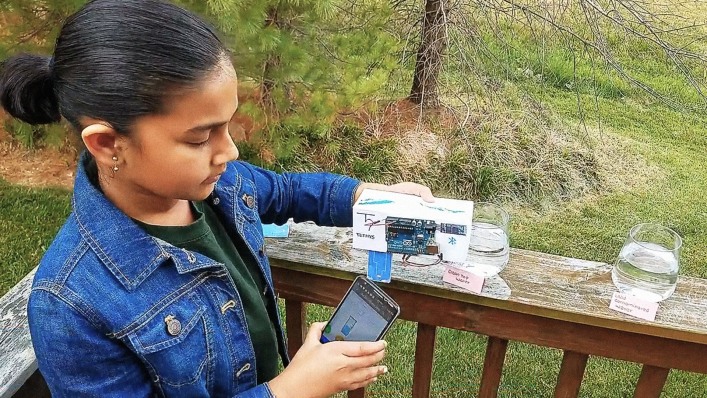
Gitanjali Rao, who competed in a distinguished science competition in the United States, won the 3M-sponsored science competition and was awarded the title of “America’s Top Young Scientist,” along with a $25,000 prize.
Her invention, a sophisticated method for testing for lead contamination in water, could significantly improve the response to chemical disasters like the water crisis in Flint, Michigan. In fact, Rao’s water-testing device was partially inspired by stories of chemical contamination such as the situation in Flint.
“Imagine living day in and day out drinking contaminated water with dangerous substances like lead,” Rao explained in her entry. “Millions of people around the world are exposed to water containing lead and its harmful side effects. My solution addresses a core issue of speedy detection of lead contamination, allowing preventative action and even saving lives!”
Rao is a student at Brentwood Middle School in Brentwood, Tennessee, and was one of just 10 finalists in the 2017 Discovery Education 3M Young Scientist Challenge. It’s a one-of-a-kind video competition aimed at sparking the imaginations of students across the country.
“3M’s commitment to the next generation of science leaders is energized each year by the creativity and ingenuity of these young scientists,” said Paul Keel, senior vice president, business development and marketing-sales for 3M. “Making the world a better place starts with a spark of curiosity, which leads to passion — and results in making an impact. 3M is inspired by these finalists and their contributions to making lives better.”
Rao’s enthusiasm is infectious, and her solution is positively radical. In reading through materials on the Massachusetts Institute of Technology’s Material Science and Engineering website (as typical seventh-graders are not known to do), Rao learned about a new type of nanotechnology — and made the correlative leap to recognize a new practical application for it.
Her test device, which she has dubbed “Tethys,” uses a disposable cartridge containing chemically treated carbon nanotube arrays. This connects with an Arduino technology-based signal processor with a Bluetooth attachment. The graphene within the nanotube is highly sensitive to changes in flow of current. By treating the tube with atoms that are sensitive to lead, Rao’s device is able to measure whether potable water is contaminated with lead, beaming the results straight to a Bluetooth-enabled smartphone. When it detects levels higher than 15 parts per million, the device warns that the water is unsafe.

Even the name of the device is clever — in Greek mythology, “Tethys” is the Titan daughter of Uranus (Earth) and Gaius (Sky), and the mother of river gods.
Rao’s Tethys device offers real innovation in allowing live testing for chemical contaminants. Homeowners currently have to ship a kit to a chemical lab and wait a week or more for results. Moreover, most of the testing device is reusable, meaning it could potentially be produced at mass-market costs. Rao estimates that a Tethys kit could potentially cost as little as $20 or less.
Tethys isn’t Rao’s first invention. She was the first girl in Middle Tennessee to earn the designation of STEM Scout of the Year from the Boy Scouts of America — Middle Tennessee Council for inventing a device that can determine the kind and amount of toxin in a snakebite. She also placed third in the EngineerGirl Essay Contest with her essay, “Saving Mountain Gorillas with Machine Learning and Predictive Analytics,” and she’s won the National Association of State Aviation Officials Tennessee Art Contest three years running.
During the competition, Rao was paired with Dr. Kathleen Shafer, a 3M research scientist who develops new plastics technologies that have real-world applications in dentistry and other fields, to explore developing a product that people can buy. In future years, Rao hopes to become a geneticist or an epidemiologist, working in the field of disease theory.
On the Discovery Education 3M Young Scientist Challenge website, Rao offers advice for other kids. “Just have fun,” she said. “There’s never a limit to how many times you want to keep trying and tweaking your projects. Keep trying, and one day, you’ll figure it out.”


